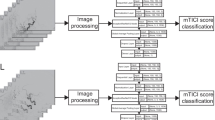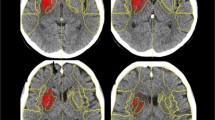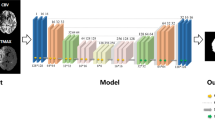Abstract
Purpose
Intra-procedural assessment of reperfusion during mechanical thrombectomy (MT) for emergent large vessel occlusion (LVO) stroke is traditionally based on subjective evaluation of digital subtraction angiography (DSA). However, semi-quantitative diagnostic tools which encode hemodynamic properties in DSAs, such as angiographic parametric imaging (API), exist and may be used for evaluation of reperfusion during MT. The objective of this study was to use data-driven approaches, such as convolutional neural networks (CNNs) with API maps, to automatically assess reperfusion in the neuro-vasculature during MT procedures based on the modified thrombolysis in cerebral infarction (mTICI) scale.
Methods
DSAs from patients undergoing MTs of anterior circulation LVOs were collected, temporally cropped to isolate late arterial and capillary phases, and quantified using API peak height (PH) maps. PH maps were normalized to reduce injection variability. A CNN was developed, trained, and tested to classify PH maps into 2 outcomes (mTICI 0,1,2a/mTICI 2b,2c,3) or 3 outcomes (mTICI 0,1,2a/mTICI 2b/mTICI 2c,3), respectively. Ensembled networks were used to combine information from multiple views (anteroposterior and lateral).
Results
The study included 383 DSAs. For the 2-outcome classification, average accuracy was 81.0% (95% CI, 79.0–82.9%), and the area under the receiver operating characteristic curve (AUROC) was 0.86 (0.84–0.88). For the 3-outcome classification, average accuracy was 64.0% (62.0–66.0), and AUROC values were 0.85 (0.83–0.87), 0.74 (0.71–0.77), and 0.78 (0.76–0.81) for the mTICI 0,1,2a, mTICI 2b, and mTICI 2c,3 classes, respectively.
Conclusion
This study demonstrated the feasibility of using hemodynamic information in API maps with data-driven models to autonomously assess intra-procedural reperfusion during MT.




Similar content being viewed by others
Abbreviations
- AIS:
-
Acute ischemic stroke
- AP:
-
Anteroposterior
- API:
-
Angiographic parametric imaging
- AUROC:
-
Area under the ROC curve
- CAM:
-
Class activation map
- CNN:
-
Convolutional neural network
- CT:
-
Computed tomography
- DSA:
-
Digital subtraction angiography
- ICA:
-
Internal carotid artery
- LVO:
-
Large vessel occlusion
- MCA:
-
Middle cerebral artery
- MCCV:
-
Monte Carlo cross-validation
- MCC:
-
Matthews correlation coefficient
- MT:
-
Mechanical thrombectomy
- mTICI:
-
Modified TICI
- NIHSS:
-
NIH stroke score
- TDC:
-
Time density curve
- TICI:
-
Thrombolysis in cerebral infarction
- PH:
-
Peak height
- ROC:
-
Receiver operating characteristic
References
Rennert RC et al (2019) Epidemiology, natural history, and clinical presentation of large vessel ischemic stroke. Neurosurgery 85(suppl_1):S4–S8
Waqas M, Mokin M, Primiani CT, Gong AD, Rai HH, Chin F, Rai AT, Levy EI, Siddiqui AH (2020) Large vessel occlusion in acute ischemic stroke patients: a dual-center estimate based on a broad definition of occlusion site. J Stroke Cerebrovasc Dis 29(2):104504
Waqas M, Rai AT, Vakharia K, Chin F, Siddiqui AH (2020) Effect of definition and methods on estimates of prevalence of large vessel occlusion in acute ischemic stroke: a systematic review and meta-analysis. J Neurointerv Surg 12(3):260–265
Smith WS, Sung G, Saver J, Budzik R, Duckwiler G, Liebeskind DS, Lutsep HL, Rymer MM, Higashida RT, Starkman S, Gobin YP, Multi MERCI Investigators, Frei D, Grobelny T, Hellinger F, Huddle D, Kidwell C, Koroshetz W, Marks M, Nesbit G, Silverman IE (2008) Mechanical thrombectomy for acute ischemic stroke: final results of the multi MERCI trial. Stroke 39(4):1205–1212
Berlis A, Lutsep H, Barnwell S, Norbash A, Wechsler L, Jungreis CA, Woolfenden A, Redekop G, Hartmann M, Schumacher M (2004) Mechanical thrombolysis in acute ischemic stroke with endovascular photoacoustic recanalization. Stroke 35(5):1112–1116
Smith WS, Sung G, Starkman S, Saver JL, Kidwell CS, Gobin YP, Lutsep HL, Nesbit GM, Grobelny T, Rymer MM, Silverman IE, Higashida RT, Budzik RF, Marks MP (2005) Safety and efficacy of mechanical embolectomy in acute ischemic stroke: results of the MERCI trial. Stroke 36(7):1432–1438
Bourcier R, Goyal M, Liebeskind DS, Muir KW, Desal H, Siddiqui AH, Dippel DWJ, Majoie CB, van Zwam WH, Jovin TG, Levy EI, Mitchell PJ, Berkhemer OA, Davis SM, Derraz I, Donnan GA, Demchuk AM, van Oostenbrugge RJ, Kelly M, Roos YB, Jahan R, van der Lugt A, Sprengers M, Velasco S, Lycklama à Nijeholt GJ, Ben Hassen W, Burns P, Brown S, Chabert E, Krings T, Choe H, Weimar C, Campbell BCV, Ford GA, Ribo M, White P, Cloud GC, San Roman L, Davalos A, Naggara O, Hill MD, Bracard S, for the HERMES Trialists Collaboration (2019) Association of time from stroke onset to groin puncture with quality of reperfusion after mechanical thrombectomy: a meta-analysis of individual patient data from 7 randomized clinical trials. JAMA Neurology 76(4):405–411
Evans MR et al (2017) Revolution in acute ischaemic stroke care: a practical guide to mechanical thrombectomy. Pract Neurol 17(4):252–265
Rava RA et al (2020) Assessment of computed tomography perfusion software in predicting spatial location and volume of infarct in acute ischemic stroke patients: a comparison of Sphere, Vitrea, and RAPID. J Neurointerv Surg
Higashida RT, Furlan AJ (2003) Trial design and reporting standards for intra-arterial cerebral thrombolysis for acute ischemic stroke. Stroke 34(8):e109–e137
Almekhlafi MA, Mishra S, Desai JA, Nambiar V, Volny O, Goel A, Eesa M, Demchuk AM, Menon BK, Goyal M (2014) Not all “successful” angiographic reperfusion patients are an equal validation of a modified TICI scoring system. Interv Neuroradiol 20(1):21–27
Kallmes DF (2012) TICI: if you are not confused, then you are not paying attention. Am J Neuroradiol 33(5):975–976
Sattar A et al (2014) E-011 TICI quantified: automated cerebral revascularization grading in acute ischemic stroke. J NeuroInterv Surg 6(Suppl 1):A43–A43
De Leacy RA et al (2019) Wide-neck bifurcation aneurysms of the middle cerebral artery and basilar apex treated by endovascular techniques: a multicentre, core lab adjudicated study evaluating safety and durability of occlusion (BRANCH). Journal of NeuroInterventional Surgery 11(1):31–36
Rezek I, Mousan G, Wang Z, Murad MH, Kallmes DF (2013) Effect of core laboratory and multiple-reader interpretation of angiographic images on follow-up outcomes of coiled cerebral aneurysms: a systematic review and meta-analysis. Am J Neuroradiol 34(7):1380–1384
Zhang G, Treurniet KM, Jansen IGH, Emmer BJ, van den Berg R, Marquering HA, Uyttenboogaart M, Jenniskens SFM, Roos YBWEM, van Doormaal PJ, van Es ACGM, van der Lugt A, Vos JA, Lycklama à Nijeholt GJ, van Zwam WH, Shi H, Yoo AJ, Dippel DWJ, Majoie CBLM, for the MR CLEAN Registry Investigators (2018) Operator versus core lab adjudication of reperfusion after endovascular treatment of acute ischemic stroke. Stroke 49(10):2376–2382
Bhurwani, M.M.S., et al. Feasibility study of deep neural networks to classify intracranial aneurysms using angiographic parametric imaging. In Medical Imaging 2019: Computer-Aided Diagnosis. 2019. International Society for Optics and Photonics
Thompson HK Jr et al (1964) Indicator transit time considered as a gamma variate. Circ Res 14(6):502–515
Albers GW, Wald MJ, Mlynash M, Endres J, Bammer R, Straka M, Maier A, Hinson HE, Sheth KN, Taylor Kimberly W, Molyneaux BJ (2019) Automated calculation of Alberta stroke program early CT score: validation in patients with large hemispheric infarct. Stroke 50(11):3277–3279
Bhurwani, M.M.S., et al., Feasibility study for use of angiographic parametric imaging and deep neural networks for intracranial aneurysm occlusion prediction. Journal of NeuroInterventional Surgery, 2019
Mokin M, Khalessi AA, Mocco J, Lanzino G, Dumont TM, Hanel RA, Lopes DK, Fessler RD, Ringer AJ, Bendok BR, Veznedaroglu E, Siddiqui AH, Hopkins LN, Levy EI (2014) Endovascular treatment of acute ischemic stroke: the end or just the beginning? Neurosurg Focus 36(1):E5
Zaidat OO, Yoo AJ, Khatri P, Tomsick TA, von Kummer R, Saver JL, Marks MP, Prabhakaran S, Kallmes DF, Fitzsimmons BF, Mocco J, Wardlaw JM, Barnwell SL, Jovin TG, Linfante I, Siddiqui AH, Alexander MJ, Hirsch JA, Wintermark M, Albers G, Woo HH, Heck DV, Lev M, Aviv R, Hacke W, Warach S, Broderick J, Derdeyn CP, Furlan A, Nogueira RG, Yavagal DR, Goyal M, Demchuk AM, Bendszus M, Liebeskind DS, Cerebral Angiographic Revascularization Grading (CARG) Collaborators, STIR Revascularization working group, STIR Thrombolysis in Cerebral Infarction (TICI) Task Force (2013) Recommendations on angiographic revascularization grading standards for acute ischemic stroke: a consensus statement. Stroke 44(9):2650–2663
Chollet, F., Keras. 2015
Bluemke DA et al (2019) Assessing radiology research on artificial intelligence: a brief guide for authors, reviewers, and readers-from the Radiology Editorial Board. Radiology 294:192515
Xu Q-S, Liang Y-Z (2001) Monte Carlo cross validation. Chemom Intell Lab Syst 56(1):1–11
Storn R, Price K (1997) Differential evolution–a simple and efficient heuristic for global optimization over continuous spaces. J Glob Optim 11(4):341–359
Virtanen P et al (2020) SciPy 1.0: fundamental algorithms for scientific computing in Python. Nat Methods 17(3):261–272
Zhou, B., et al. Learning deep features for discriminative localization. in Proceedings of the IEEE conference on computer vision and pattern recognition. 2016
Matthews BW (1975) Comparison of the predicted and observed secondary structure of T4 phage lysozyme. Biochim Biophys Acta (BBA)-Protein Struct 405(2):442–451
Chicco D, Jurman G (2020) The advantages of the Matthews correlation coefficient (MCC) over F1 score and accuracy in binary classification evaluation. BMC Genomics 21(1):6
Goyal M, Menon BK, van Zwam WH, Dippel DWJ, Mitchell PJ, Demchuk AM, Dávalos A, Majoie CBLM, van der Lugt A, de Miquel MA, Donnan GA, Roos YBWEM, Bonafe A, Jahan R, Diener HC, van den Berg LA, Levy EI, Berkhemer OA, Pereira VM, Rempel J, Millán M, Davis SM, Roy D, Thornton J, Román LS, Ribó M, Beumer D, Stouch B, Brown S, Campbell BCV, van Oostenbrugge RJ, Saver JL, Hill MD, Jovin TG (2016) Endovascular thrombectomy after large-vessel ischaemic stroke: a meta-analysis of individual patient data from five randomised trials. Lancet 387(10029):1723–1731
Dargazanli C, Fahed R, Blanc R, Gory B, Labreuche J, Duhamel A, Marnat G, Saleme S, Costalat V, Bracard S, Desal H, Mazighi M, Consoli A, Piotin M, Lapergue B, Redjem H, Ciccio G, Smajda S, Desilles JP, Rodesch G, Coskun O, di Maria F, Bourdain F, Decroix JP, Wang A, Tchikviladze M, Evrard S, Eker O, Turjman F, Labeyrie PE, Riva R, Mounayer C, Saleme S, Bonafé A, Gascou G, Tonnelet R, Derelle AL, Anxionnat R, Bourcier R, Daumas-Duport B, Berge J, Barreau X, Djemmane L (2018) Modified thrombolysis in cerebral infarction 2C/thrombolysis in cerebral infarction 3 reperfusion should be the aim of mechanical thrombectomy: insights from the ASTER trial (Contact Aspiration Versus Stent Retriever for Successful Revascularization). Stroke 49(5):1189–1196
Cramer H (1946) Mathematical methods of statistics. Princeton University Press, Princeton
Powers, D.M., Evaluation: from precision, recall and F-measure to ROC, informedness, markedness and correlation. 2011
Podgorsak, A., et al. Initial evaluation of the use of a convolutional neural network to determine coronary artery disease severity using computed tomography angiography. in Medical physics. 2019. WILEY 111 RIVER ST, HOBOKEN 07030–5774, NJ USA
Contributors
MMSB, KVS, MM, AHS, and CNI conceived and designed the research.
JMD, EIL, KVS, and AHS performed all the clinical procedures.
MMSB, MW, RAR, and CNI collected the data.
MMSB analyzed the data.
MMSB performed the statistical analysis.
CNI handled funding and supervision.
MMSB drafted the manuscript.
All authors made critical revisions of the manuscript and reviewed the final version.
Code availability
Additional data may be made available by contacting the corresponding author.
Data availability
Additional data may be made available by contacting the corresponding author.
Funding
This work is supported by the James H. Cummings Foundation and the University at Buffalo Clinical and Translational Science Institute (CTSI).
Author information
Authors and Affiliations
Corresponding author
Ethics declarations
Competing interests
Maxim Mokin—Grants: Principal investigator NIH R21NS109575. Consultant: Medtronic, Cerenovus. Stock options: Serenity Medical, Synchron, Endostream, VICIS.
Ciprian Ionita—Equipment grant from Canon Medical Systems, support from the Cummings Foundation, NIH R21 grant.
Jason Davies—Research grant: National Center for Advancing Translational Sciences of the National Institutes of Health under award number KL2TR001413 to the University at Buffalo. Speakers’ bureau: Penumbra; Honoraria: Neurotrauma Science, LLC. Shareholder/ownership interests: RIST Neurovascular.
Kenneth Snyder—Consulting and teaching for Canon Medical Systems Corporation, Penumbra Inc., Medtronic, and Jacobs Institute. Co-Founder: Neurovascular Diagnostics, Inc.
Elad Levy—Shareholder/ownership interests: NeXtGen Biologics, RAPID Medical, Claret Medical, Cognition Medical, Imperative Care (formerly the Stroke Project), Rebound Therapeutics, StimMed, Three Rivers Medical. National Principal Investigator/Steering Committees: Medtronic (merged with Covidien Neurovascular) SWIFT Prime and SWIFT Direct Trials. Honoraria: Medtronic (training and lectures). Consultant: Claret Medical, GLG Consulting, Guidepoint Global, Imperative Care, Medtronic, Rebound, StimMed. Advisory Board: Stryker (AIS Clinical Advisory Board), NeXtGen Biologics, MEDX, Cognition Medical, Endostream Medical. Site Principal Investigator: CONFIDENCE study (MicroVention), STRATIS Study—Sub I (Medtronic).
Adnan Siddiqui—Research grant: NIH/NINDS 1R01NS091075 as a co-investigator for “Virtual Intervention of Intracranial Aneurysms.” Financial interest/investor/stock options/ownership: Amnis Therapeutics, Apama Medical, Blink TBI Inc., Buffalo Technology Partners Inc., Cardinal Consultants, Cerebrotech Medical Systems, Inc., Cognition Medical, Endostream Medical Ltd., Imperative Care, International Medical Distribution Partners, Neurovascular Diagnostics Inc., Q’Apel Medical Inc., Rebound Therapeutics Corp., Rist Neurovascular Inc., Serenity Medical Inc., Silk Road Medical, StimMed, Synchron, Three Rivers Medical Inc., Viseon Spine Inc. Consultant/advisory board: Amnis Therapeutics, Boston Scientific, Canon Medical Systems USA Inc., Cerebrotech Medical Systems Inc., Cerenovus, Corindus Inc., Endostream Medical Ltd., Guidepoint Global Consulting, Imperative Care, Integra LifeSciences Corp., Medtronic, MicroVention, Northwest University–DSMB Chair for HEAT Trial, Penumbra, Q’Apel Medical Inc., Rapid Medical, Rebound Therapeutics Corp., Serenity Medical Inc., Silk Road Medical, StimMed, Stryker, Three Rivers Medical, Inc., VasSol, W.L. Gore & Associates. Principal investigator/steering comment of the following trials: Cerenovus LARGE and ARISE II; Medtronic SWIFT PRIME and SWIFT DIRECT; MicroVention FRED & CONFIDENCE; MUSC POSITIVE; and Penumbra 3D Separator, COMPASS, and INVEST.
Ethics approval
Institutional review board approval was obtained, and informed consent was waived for this Health Insurance Portability and Accountability Act–compliant retrospective study (IRB ID: STUDY00001529).
Informed consent
This is a retrospective study; hence, no informed consent is needed.
Additional information
Publisher’s note
Springer Nature remains neutral with regard to jurisdictional claims in published maps and institutional affiliations.
Rights and permissions
About this article
Cite this article
Shiraz Bhurwani, M., Snyder, K.V., Waqas, M. et al. Use of quantitative angiographic methods with a data-driven model to evaluate reperfusion status (mTICI) during thrombectomy. Neuroradiology 63, 1429–1439 (2021). https://doi.org/10.1007/s00234-020-02598-3
Received:
Accepted:
Published:
Issue Date:
DOI: https://doi.org/10.1007/s00234-020-02598-3




